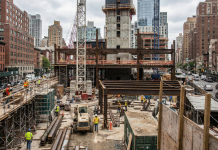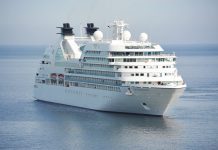In today’s US construction news, learn about an 84,000-square-foot leisure center in the Gulf Coast port city of Mobile that is surveyed by a disgruntled Robby Robertson, superintendent of a construction site, under a scorching Alabama sky. On the other hand, to fulfill its commitments under the AUKUS agreement with Australia and the United Kingdom, the U.S. industrial base needs to increase its production of attack submarines, the Navy’s nominee to lead the Navy informed Congress on Thursday.
Construction Was Completed on Time and Within Budget
Original Source: This construction project was on time and on budget. Then came ICE.
Robby Robertson, a disgruntled building site superintendent, assesses an 84,000-square-foot, mostly constructed leisure center outside Mobile, Alabama, under a hot Alabama sky.
Scarily quiet location. Last month, the $20 million project was on target for November 1 completion. After almost half of his workers, spooked by an Immigration and Customs Enforcement raid on a Florida job site 230 miles (370 kilometers) away, stayed away, Robertson expects a three-week delay.
Reuters interviews report that Donald Trump’s nationwide campaign on workplace immigration searches is disrupting the construction industry.
“The threats and reporting of raids have caused workers to not show up at job sites, just whole crews for fear of a raid,” said Jim Tobin, CEO of the 140,000-member National Association of Home Builders.
In recent weeks, immigration enforcement agents have detained farmworkers, restaurant workers, meat packers, and day laborers, but the construction industry is especially vulnerable to labor supply disruptions, according to Reuters interviews and government data.
Reuters questioned 14 construction CEOs, trade organization officials, and site supervisors who said the searches are delaying projects, increasing costs, and worsening skilled labor shortages. They stated it was too early to estimate lost labor and revenue.
Reuters spoke to folks in Texas and Florida, where raids had occurred. ICE has been active in California, Illinois, Washington, Louisiana, and Massachusetts, construction association officials said.
According to the Migration Policy Institute, a nonpartisan think tank, 1.4 million of the 11 million illegal immigrants work in construction, more than any other industry.
According to U.S. Census Bureau data, construction investment reached a record high in May 2024 but fell 3.5% this May, an annual dip rarely seen outside of recessions.
Public opinion is shifting on deportation. In a Reuters/Ipsos poll this month, Trump’s immigration approval rating dropped to 41%, his lowest since taking office.
ICE spokesperson Tricia McLaughlin said such raids combated harmful practices including labor trafficking and exploitation.
“Worksite enforcement remains a cornerstone of our efforts to protect public safety, national security, and economic stability,” stated.
COST SPIRALS
Due to the possibility for rising expenses and delays, the raids are particularly noticeable at Robertson’s construction site.
Following a May 29 immigration raid in Tallahassee, Florida, that detained 100 workers, Robertson claims the issues began.
Most of his 100-plus Mexican and Central American staff skipped work for several days. Seven weeks later, slightly over half of those immigrant workers had returned, leaving Robertson short-staffed.
The 22-person roofing crew is reduced to 12. The roof, which should be finished by now, is unfinished, exposing the interior to rain throughout thunderstorm season.
Electrical work, plumbing, dry wall finishing, and sports equipment installation are behind schedule.
Robertson said a “liquidated damages” clause of $4,000 per day the job takes longer than November 1 could cost his company $84,000.
“I am a Trump supporter, but I just don’t think the raids is the answer,” said.
He said the corporation and its subcontractors use the government’s E-Verify program to verify workers’ legal status.
Because immigrants can fabricate documents, industry leaders said E-Verify is not failsafe.
Robertson said legitimate Hispanic workers fear ICE detention “because to their skin tone. They are afraid because they look the part.”
Most native-born Americans lack the skills to replace Mexican and Central American construction workers, according to Tim Harrison, whose company is building the leisure complex.
A tight job market makes it hard to find replacement workers in Alabama, he said. The state’s unemployment is 3.2%.
Republicans abound in contracting. Not anti-ICE. We support the president’s efforts. However, our sector needs Hispanic immigrants “Harrison stated.
CEOs blamed a lack of investment in teaching native-born Americans plastering, carpentry, roofing, and welding.
The White House and Labor Department cited Trump’s April executive order to encourage over a million skilled apprenticeships, including construction skills.
“There is no shortage of American minds and hands to grow our labor force, and President Trump’s agenda to create jobs for American workers represents this Administration’s commitment to capitalizing on that untapped potential while delivering on our mandate to enforce our immigration laws,” Abigail Jackson, a spokeswoman for
The Labor Department established the Office of Immigration Policy in June to streamline foreign worker temporary work permits.
Danger Pay
Brent Taylor, a Tampa construction company owner, says the ICE raids have affected more than jobs. It directly affects his labor costs.
Nearly 25% of Florida’s population is immigrant. Taylor lost 30–50% of his subcontracted roofing, concrete, and dry wall workers.
He stated his subcontractors must pay extra to replace them.
Some of his subcontracted immigrant workers want extra pay to avoid ICE detention. That has raised daily labor costs to $400–$500 from $200–$300.
Taylor added “they’re factoring in basically a hazard rate”. “And then I’m going to pass it on to my customer, whether it be a homeowner, or a commercial building owner.”
This month, building trade associations, farm, hotel, restaurant, and other representatives convened in Washington to petition the Departments of Labor and Homeland Security for reform.
Most want a procedure to temporarily legalize foreign-born U.S. workers who pass background checks for construction jobs. That is unlikely to pass Congress since many Republicans reject it.
Associated General Contractors of America vice president of public affairs Brian Turmail said the group underlined the harm caused by ICE raids at its talks with DHS and Labor authorities. The Trump administration should prioritize criminally convicted illegal immigrants and allow others to work, they said.
“For 40 years, this country has done little to encourage or prepare American workers for careers in fields like construction,” said Turmail.
He said the officials listened, but the delegation left with the impression that the Trump administration believes lower-income Americans who must work to get health insurance can replace illegal immigrants.
Amnesty is strongly opposed by administration officials. “They won’t go there,” said another trade organization representative who has met with administration officials.
Harrison, Alabama’s construction CEO, said several contractors are encountering cost overruns and delays due to worker disappearance.
“That’s because of the fear that’s out there, the hysteria that’s out there,” stated.
Mobile’s Tim Reid reports. Additional reporting by Jorge Garcia in Mobile and Dan Burns in NYC. Ross Colvin and Suzanne Goldenberg edited.
Caudle Says Sub Construction Pace Must Grow to Fulfill AUKUS Promise
Original Source: CNO Nominee Caudle Says Sub Construction Pace Needs to Grow to Deliver on AUKUS Promise
The Navy’s choice to lead the Navy told Congress Thursday that the U.S. industrial base must treble attack submarine output to meet AUKUS agreements with Australia and the UK.
In his Senate Armed Services Committee confirmation hearing to become chief of naval operations, Adm. Daryl Caudle praised Royal Australian Navy (RAN) submariners and said the Pentagon-wide AUKUS partnership review is about U.S. industrial capacity.
“The question of Australia’s ability to conduct undersea warfare is not in question by me or by anyone,” Caudle told SASC seapower subcommittee head Sen. Tim Kaine (D-Va.). But as you know, the delivery pace is not fast enough to fulfill Pillar 1 of the AUKUS agreement, which our Defense Department is reviewing.
The Pentagon is reevaluating AUKUS, which would allow the U.S. to share nuclear propulsion technology for the second time, to ensure it meshes with Trump administration priorities, USNI News reported last month. Elbridge Colby, the under secretary of defense for policy, is assessing the pact, which could see the U.S. sell up to five Virginia-class attack boats to the RAN while helping Australia build and maintain nuclear-powered attack submarines.
Navy officials said the U.S. industrial base needs build 2.33 attack boats and one Columbia-class nuclear ballistic missile submarine per year to sell Virginia boats to Australia. The industrial base develops 1.3 assault boats annually.
Caudle agreed with SASC Chairman Sen. Roger Wicker (R-Miss.) that the U.S. Navy and military industrial base must make major reforms to allow General Dynamics Electric Boat and HII’s Newport News Shipbuilding to build twice as many attack submarines.
“We do have to understand whether or not the industrial base can produce the submarines required so that we can make good on the actual pact that we made with the U.K. and Australia, which is around 2.2., 2.3 Virginia-class submarines per year,” Caudle told senator “That requires a transformational improvement, not a 10%, 20%, or 100% improvement.”
To boost build rate, Caudle suggested inventiveness, outsourcing, and limiting shipyard attrition. He told Congress that capacity is the main obstacle the U.S. Navy faces in countering China and managing global threats.
Caudle, the commander of U.S. Fleet Forces and a career submariner, supported working with international partners to maintain and repair U.S. ships and said he would evaluate how other nations may help with capacity issues.
“I don’t know how we do what we need to do without bringing international partners into the capacity problem that we have while we build up our capacity because we need ships today,” Caudle told Sen. Tommy Tuberville (R-Ala. “So there are no magic beans. Nothing will automatically do that. So the solution space has got to open up, and I think part of that has to look at international partnerships to give us a little bit of a relief valve while we work on our own organic industrial capacity.”
The potential to lean on allies and partners for help maintaining and building ships has received bipartisan support over the last year. Military Sea Lift Command hired Hanwhaah Ocean in South Korea to maintain USNS Wally Schirra for seven months.
Caudle supported the Marine Corps’ 31-ship inventory and observed that the Navy last maintained a 3.0 Amphibious Ready Group/Marine Expeditionary Unit presence in the 1990s with 37–40 amphibious warships.
“With our model that we currently have, even if the maintenance challenges that I can discuss with our amphib readiness, were not in play, a 3.0 ARG/MEU presence would not be capable with a 31-ship force structure,” he said.
The Marine Corps backed away from its 38-ship requirement for the amphibious fleet in 2019 under former Commandant Gen. David Berger. Since then, Congress has made it law that the Navy must maintain 31 amphibious warships in the fleet.
But the Navy’s amphibs have faced readiness challenges in recent years that caused delayed and disaggregated deployments. A December report from the Government Accountability Office found that amphibious warships had a 46 percent readiness rate – the percentage of time they were fit to deploy – below the 50 percent requirement.
Caudle and Naval Surface Forces commander Vice Adm. Brendan McLane are investigating maintenance and parts issues to improve amphibious readiness.
“To the 3.0 part about that, I consider that to be a commitment that I have with [Marine Corps Commandant Gen.] Eric Smith,” Caudle later said during an exchange with Sen. Dan Sullivan (R-Alaska).
“I can’t deliver that today with the readiness that I have. He needs that for force structure assumptions. And so I recognize that, and he and I have talked about that and going forward, it’s my goal to actually put the effort and energy in to deliver the most our amphibious force can do.”
Summary of today’s construction news
In summary, the construction sector is being disrupted by ICE raids, which are also making the labor crisis worse. CEOs claim that project delays and cost overruns are being caused by raids. To evade deportation, some construction workers are hiding from authorities. According to DHS, workplace raids help in the fight against exploitation and human trafficking.
On the other hand, career submariner and current U.S. Fleet Forces commander Caudle stated he would evaluate how other nations could assist the U.S. with its capacity issues and supported collaborating with foreign partners to maintain and repair U.S. ships.








